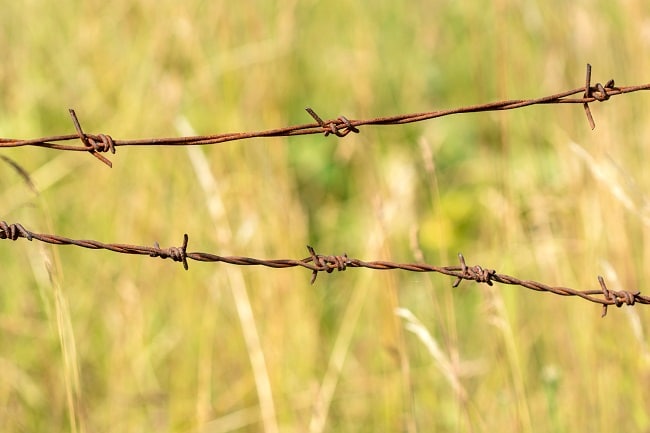The “Wild West” signifies the vast amount of land in the western portion of the United States, largely unclaimed from a legal standpoint during the era of the early 1600s to late 1800s.
In 1862, the Homestead Act was enacted, giving the opportunity for any adult US citizen (including women and freed slaves) or any aspiring citizens to claim 160 acres of government surveyed land.
The stipulations for keeping this land included building a residence and cultivating the land for five years.
At the end of this five-year period, the person could obtain permanent ownership of the land by paying a small registration fee.
An alternative option was paying the government $1.25 per acre after cultivating the land for a period of six months.
This free prairie land was characterized by tall, thick grass spreading across a vast field. Despite the ruggedness of the land, settlers came in hordes.
With the newfound land ownership, a challenge faced by many landowners was drawing boundaries to contain their property while also keeping intruders out.
So you might wonder when was the barbed wire invented?
When was the Barbed Wire Invented? Barbed Wire Patent Story
On October 27, 1873, in Dekalb, Illinois, a man named Joseph Glidden won a patent for a mechanically produced barbed wire fence.
Glidden was not the first person to receive a patent for a barbed wire fence, but his design proved the most effective and led to widespread use.
Before Glidden’s successful invention, the US Patent Office received over 200 patents for “spiked fencing” between 1867-1874. Lucien Smith is given credit for creating the idea of “thorny wire.”
A promising design was developed by Henry Rose right before released Glidden his breakthrough patent. At the county fair in 1873, Rose presented his idea for a new fence.
The design included a wooden post with spikes poking out from the sides. It is stated that Glidden saw the fence prototype of Rose and used it as inspiration for his own barbed wire invention.

The concept behind the barbed wire fence is to keep cattle away from crops and prevent large animals from breaking through normal wired fencing.
The spurs will “prick” the animals to warn them of the fence. Before the invention of barbed wire, wire fences were commonplace.
The flaw in wire fences is the weakness and ineffectiveness when faced by cattle. The cattle were strong enough to knock over this type of fence.
The other option during this time was wooden fencing. This was scarce and expensive due to the lack of trees on the western plains. The only “trees” that existed were shrubs.
The wood from these shrubs was too thin to be made into fencing. Therefore, all wood had to be imported, which was a costly endeavor.
Wood was so scarce that homesteaders used sod to build homes in the west. The western prairies were nicknamed “The American Desert.”
The barbed wire invention discovered by Glidden included a machine that would twist two wire strands around a barb.
This product differed from the previous attempts at creating barbed wire because it was not made by hand. A machine-made fence allows for mass production.
In a small period of time, the plains transformed from open fields allowing free roam to fenced plots of land. This new barbed wire was cheap, durable, easy to install, and an instant success.
The Negative Effects of Barbed Wire
With the assemblage of barbed wire fences across the west, the open-range cattle industry began to dwindle.
Ranchers could no longer herd groups of cattle across large portions of land as the plains were restricted and difficult to cross.
In addition, when blizzards occurred during winter, cattle would attempt to migrate south. The barbed wire fences would entrap the cattle, which lead to thousands of deaths.
This innovative fencing technique had a detrimental effect on other wildlife as well. The barbed wire would entangle and trap animals such as wild buffalo, leaving them to perish from hunger, thirst, or extreme infection.
In addition to the catastrophic impact barbed wire had on wildlife, it also significantly impacted conditions for Native Americans.
Before the widespread use of barbed wire fencing, all land was open for public use. Cattle could roam without restriction.
Abundant sources of food and water were available for the cattle. With fencing, these vital necessities were no longer available.
Barbed Wire Conflict- “Devil’s Rope”
This led to conflict as power was now in the hands of the landowners. Disputes also arose from fences that were illegally installed.
The “fence-cutting wars” ensued as gangs would cut down fences and leave warnings for the landowner not to rebuild.
The authorities stepped in to terminate the fence-cutting wars. However, Barbed wire fences continued to prevail.
Those with livestock but without land were forced to use rely solely on public land, which quickly became overgrazed.
Small ranch hands were coerced into working for larger ranches. Barbed wire was named “Devil’s Rope” due to its entangling effect on animals, small-time ranchers, and nomadic Native Americans.
The Native Americans were impacted the worst.
The Barbed Wire Fencing Industry
While many were suffering from barb wire, Joseph Glidden and his business partner Isaac Ellwood established The Barb Fence Company and were thriving from the boom in this newly established industry.
In 1875, a factory was built to produce barbed wire. That year, over 600,000 lbs. of barbed wire was assembled.
Glidden sold his share of the company in 1876, but Ellwood remained in the investment and continued to make a fortune.
John Warne Gates became a famous salesman of barbed wire in Texas and eventually established his own barbed wire company called the Southern Wire Company.
This manufactured barbed wire was unlicensed and called “moonshine/non-patented” barbed wire.
The Many Uses of Barbed Wire
From the beginning, barbed wire has served as a symbol of control and imprisonment. The wealthy originally purchased barbed wire to keep others out.
Shortly after its invention, however, barbed wire was used during wars as a means of protection. The military usage of barbed wire began with the British around 1888.
During the Spanish-American war, the troops guided by Teddy Roosevelt used barbed wire to defend their camps.
During World War I, barbed wire evolved to be used as a weapon. Today, it continues in prisons, concentration camps, and on national borders.
How Barbed Wire Has Evolved
Barbed wire was initially used to fence cattle, but it has since evolved and is utilized to herd other animals such as alpaca, llamas, horses, goats, and sheep.
A newer form of barbed wire, called fixed knot fences, is currently used to prevent large wild animals from reaching busy roads such as highways.
The metal used to create barbed wire has progressed through the years as well. In the 1980s, a lighter, cheaper wire was invented.
This wire was created from steel carbon fiber, adding flexibility without compromising strength. In order to prevent rust, the steel was galvanized even further in the early 2000s.
The best quality barbed wire today is now covered in a mixture of 95% aluminum and 5% zinc. Different combinations of metals have been created for a variety of situations.
The Effects of Barbed Wire
The cultural impact of barbed wire still resonates in the US today. It radically changed the land and way of life for those living in the West during the time of its invention.
It kept cattle from grazing across the prairie. The nomadic Native Americans were taken away from the open land, the only way of life they had ever known.
Shortly after its invention, barbed wire served as a useful resource in war, providing protection for troops and civilians alike.
Today, it is still used to maintain a barrier between two separate entities, but primarily in the realm of prisons and political borders.
To recognize the influence of barbed wire on American history, museums portray the history and evolution of this revolutionary invention from 1873.
The repercussions of this fencing technique are far from minimal but stay as a reminder for the American people moving forward.

